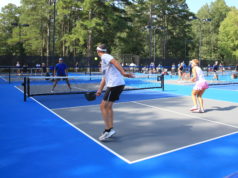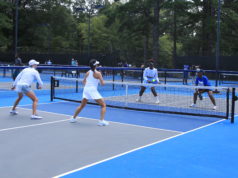THERE IS CLARITY IN THE PERCENTAGES
During playoffs this season, we noticed that three teams in the division had the same number of points and the same win percentage at the end of the season. How does ALTA decide who is first, second and third?
Holly Underwood, Sunday Women’s League Vice President
The tiebreak procedure is outlined in detail in the schedule packet for your league. Ties like this are broken by first looking at the head-to-head competition between the teams to see if there is a clear winner that took more points when each team played the others. If that doesn’t break the tie, ALTA then checks the “sets won/sets played” percentage found on each team’s tracking sheet. The team with the highest percentage would be declared in first place and the second highest would be second and so on. If the “sets won” percentage doesn’t break the tie, ALTA then looks at the “games won/games played” percentage, which is also on the tracking sheet. These steps will usually break a tie. In the unlikely event that there is still a tie, the system will randomly decide positions.
MEDICAL DELAYS CAN BE SCARY
This is a two-part question. First, during the third set of a match, one player stopped playing in the middle of a game and grabbed at his heart. He sat down for several minutes and then decided to continue. Since the game was delayed, is the game continued at the last score or does the other team win that game, due to the delay?
Second, also during the same third set, the same player again stopped play in the middle of a game and grabbed his heart. He waited several minutes and then decided to continue. After the second delay, should the other team have been awarded the set because of the continued delays? If not, how many additional delays can occur without a penalty?
Celia Sheridan, Junior Leagues Vice President
No, the team does not necessarily lose the game or set in progress when a medical condition occurs. If the player is able, play resumes where it was halted. USTA publication Friend at Court 2017, pages 97, 98 and 99, refer to medical timeouts. It concludes that a medical timeout can be taken for a treatable medical condition for three minutes to decide if the player is able to continue play, but no longer than a total of 15 minutes including any treatment that might be needed.
However, a medical timeout is not allowed for a player to recover condition. Only one medical time out may be taken for the same medical condition. Under these circumstances, your opponent should have retired the match after the second medical instance occurred. You are not required to continue play after the second occurrence of the same medical condition.
PICK IT UP! QUICK!
During my match last week, one of our opponents dropped her racquet in the middle of a point. Can our opponents call a let?
Jane Milton, VP Thursday Women’s League
Your opponent cannot call a let when dropping her racquet. This situation is explained in The Code in Friend at Court under Hindrance Issues. According to The Code, hindrance is defined as: A hindrance refers to a situation in which a player is hindered from making a shot by anything that is not within the player’s control other than a permanent fixture or a spectator’s outcry. Therefore, a player cannot call a let for a hindrance caused by something within a player’s control such as when a player’s racquet comes out of their hand, when a player’s shoe comes off, or when a player trips over the player’s own hat. However, the opponent may call a let in the case of the player’s hat coming off.




